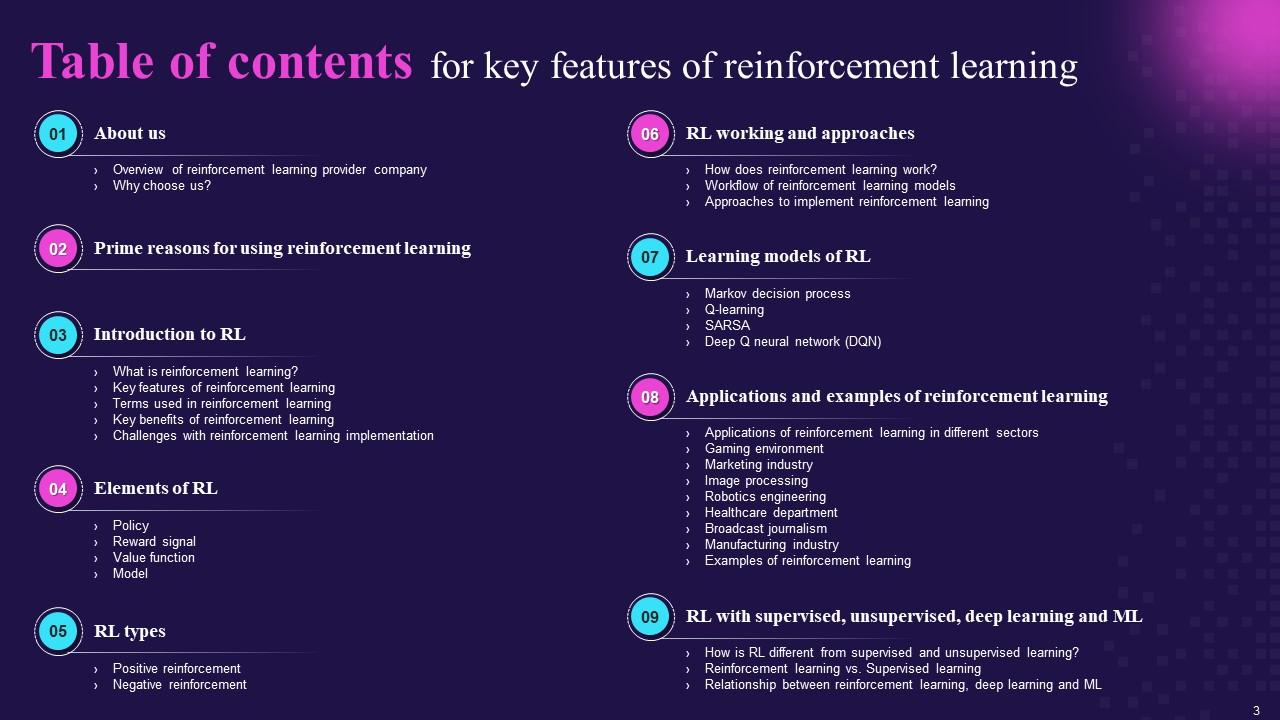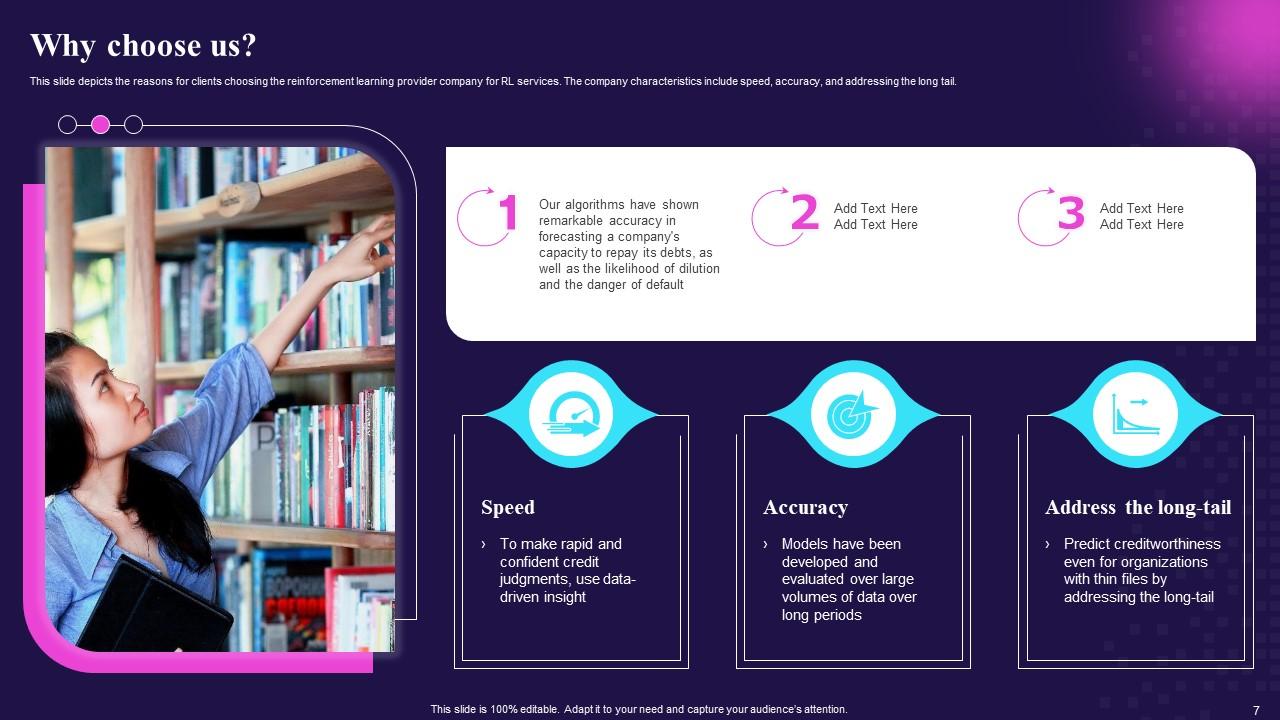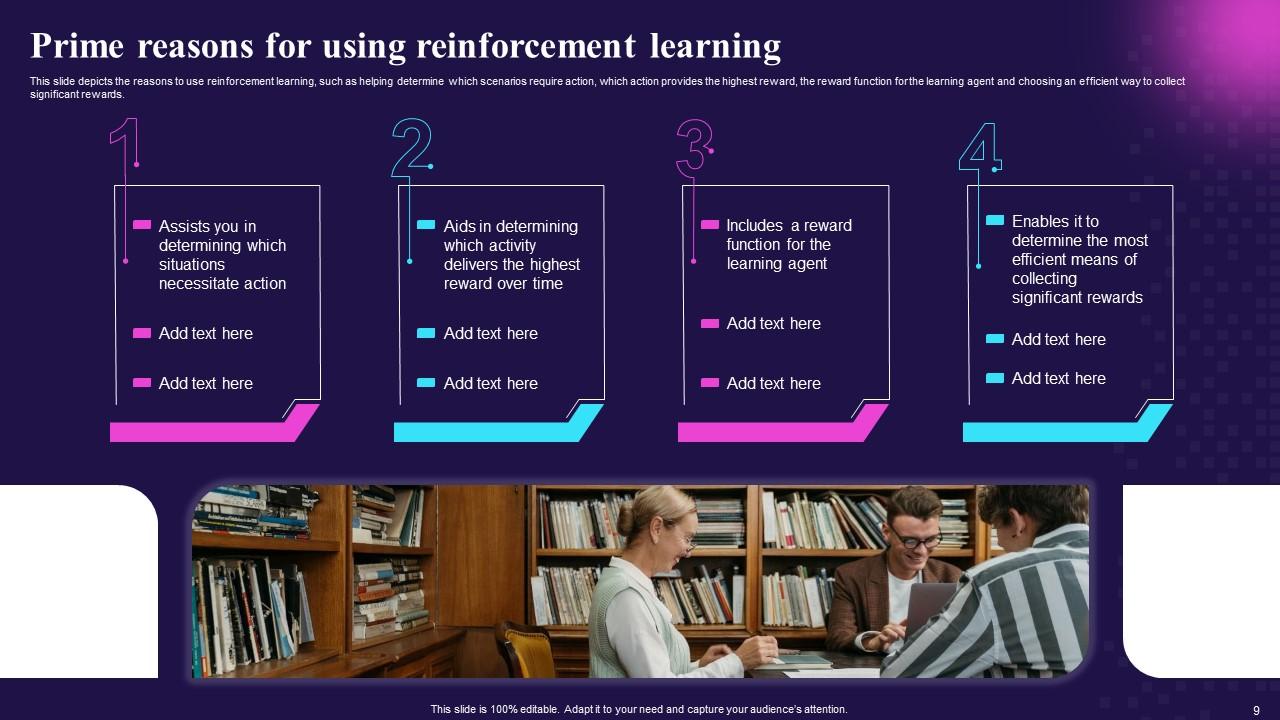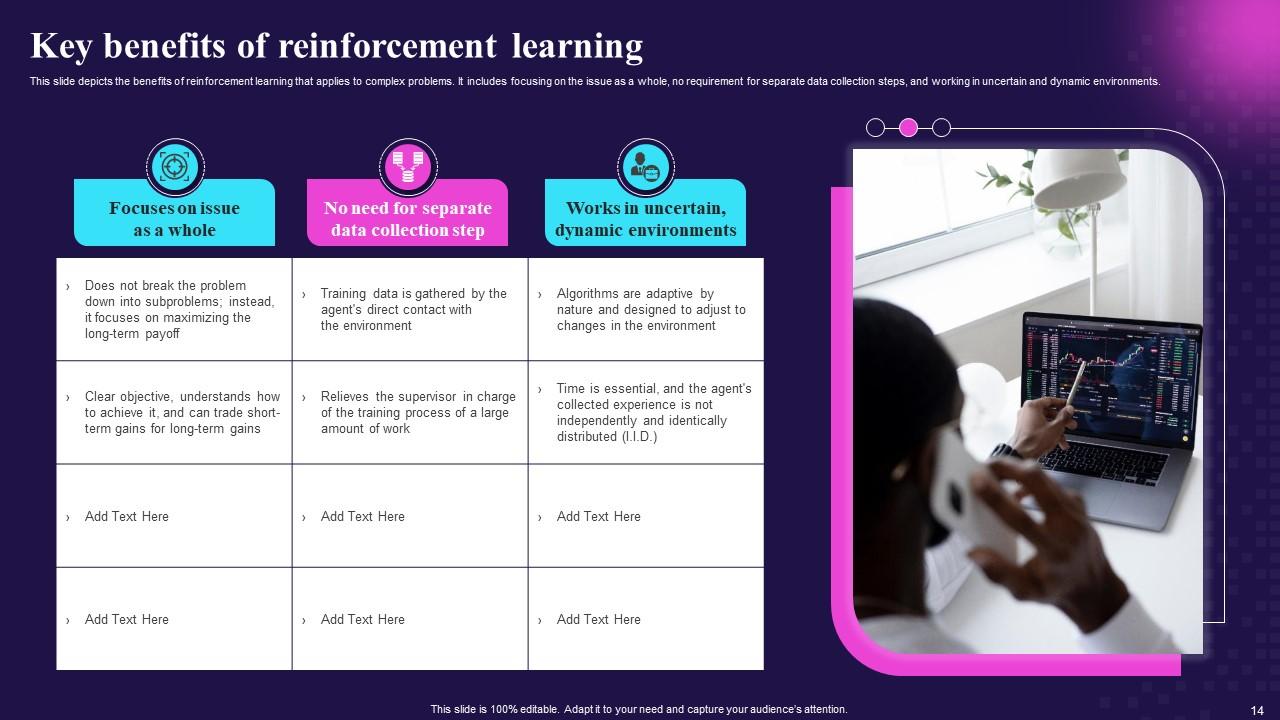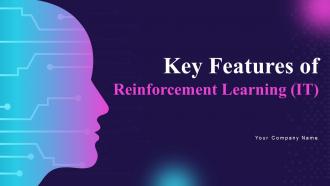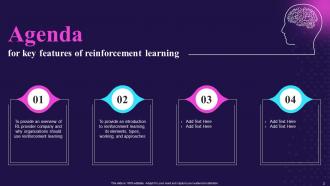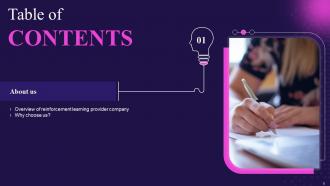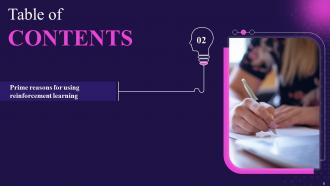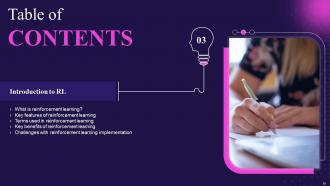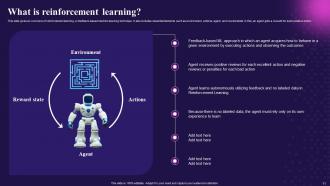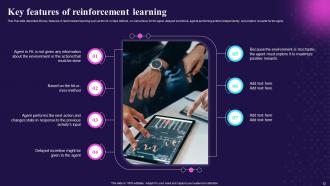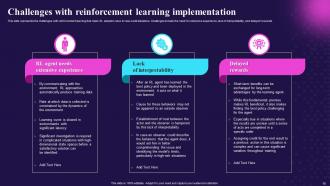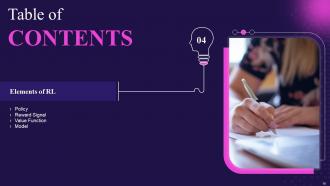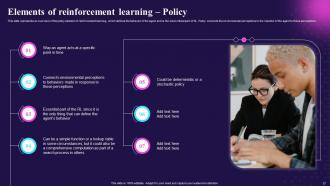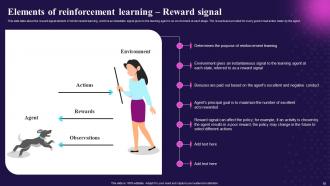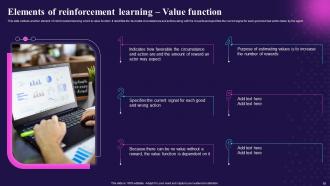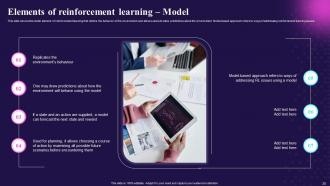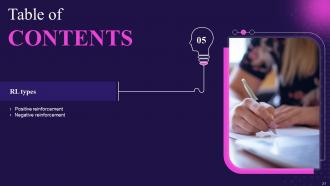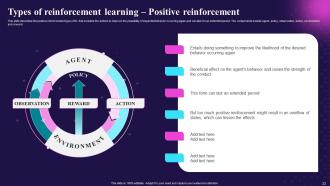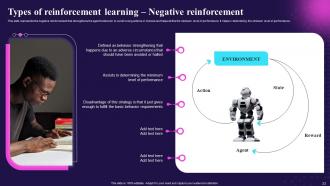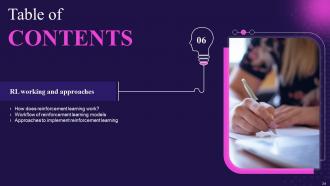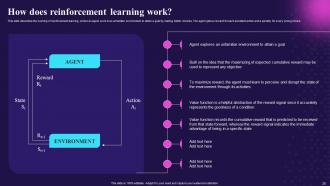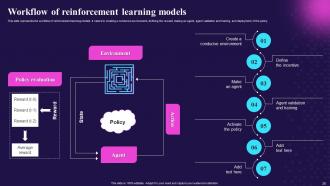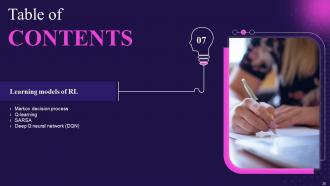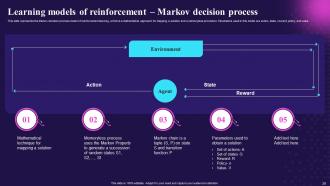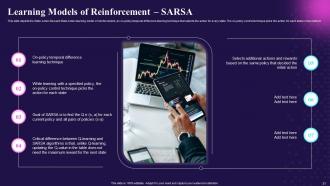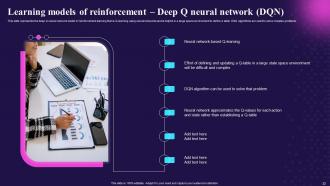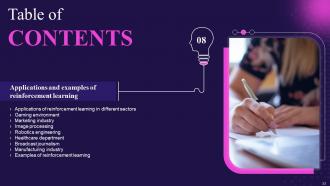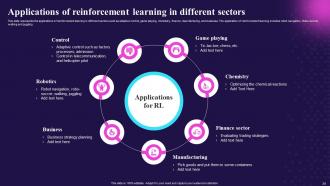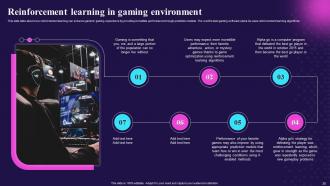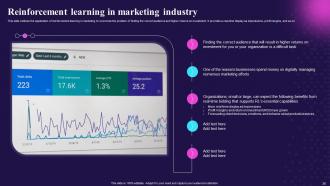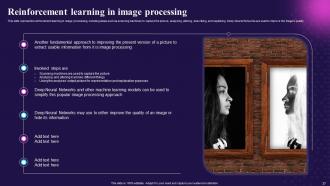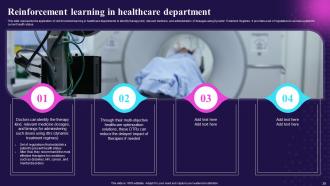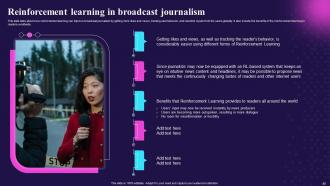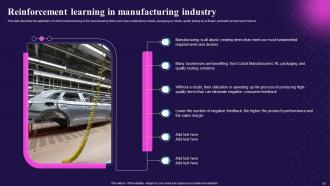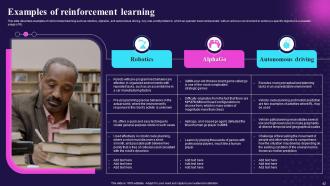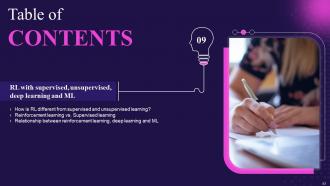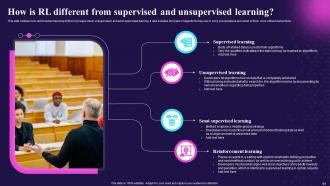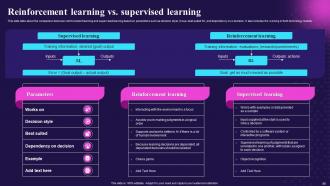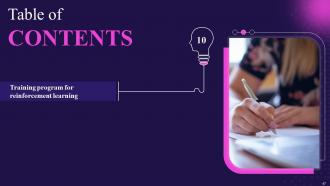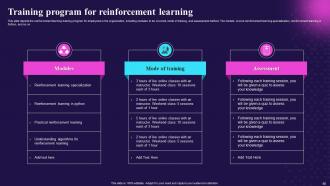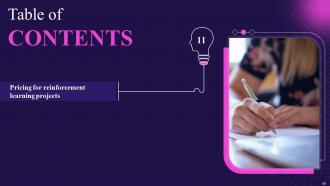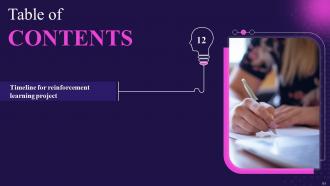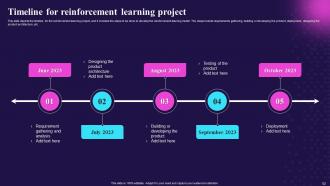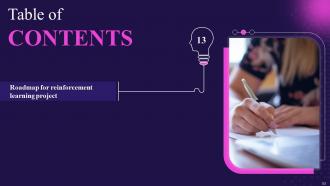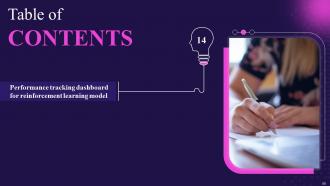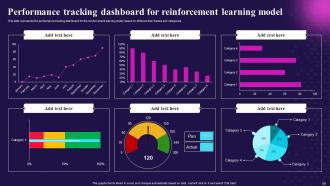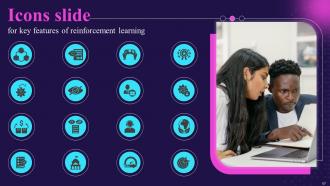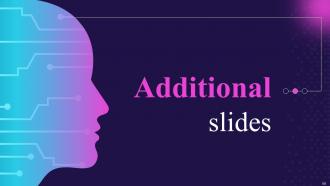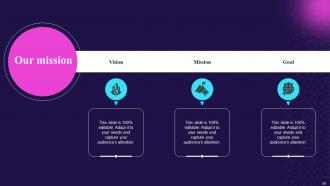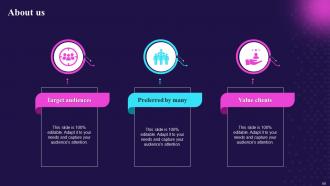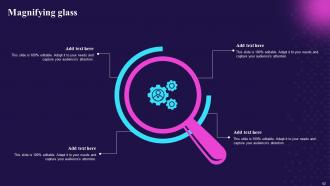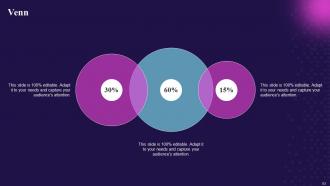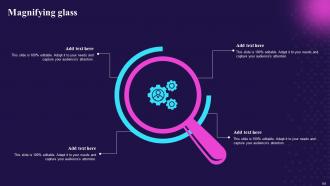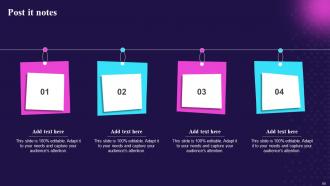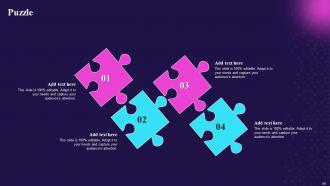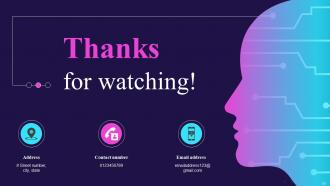Key Features Of Reinforcement Learning IT Powerpoint Presentation Slides
Discover our professionally crafted Key Features of Reinforcement Learning PowerPoint presentation. This presentation delves into the reasons for utilizing their services and introduces the fundamental concepts of reinforcement learning, including its features, key terminology, benefits, and implementation challenges. Within the Reinforcement Learning PowerPoint module, we explore the core elements of RL, such as policy, reward signal, value function, and model. Additionally, the Reinforcement Learning in ML deck presents the functioning of reinforcement learning, its workflow, various approaches, and popular learning models like the Markov Decision Process, Q-Learning, SARSA, and more. The presentation showcases practical examples of RL and its diverse applications across industries such as gaming, marketing, image processing, robotics, healthcare, broadcast journalism, and manufacturing. Moreover, it emphasizes the relationship between reinforcement learning and other learning paradigms like supervised, unsupervised, deep, and machine learning. Finally, this comprehensive Reinforcement Learning PowerPoint template offers a training program, pricing details for RL projects, a timeline, a roadmap, and a performance tracking dashboard for effectively implementing and monitoring the reinforcement learning model. Take advantage of this valuable resource - download it now.
You must be logged in to download this presentation.
 Impress your
Impress your audience
Editable
of Time
PowerPoint presentation slides
Deliver this complete deck to your team members and other collaborators. Encompassed with stylized slides presenting various concepts, this Key Features Of Reinforcement Learning IT Powerpoint Presentation Slides is the best tool you can utilize. Personalize its content and graphics to make it unique and thought-provoking. All the sixty seven slides are editable and modifiable, so feel free to adjust them to your business setting. The font, color, and other components also come in an editable format making this PPT design the best choice for your next presentation. So, download now.
People who downloaded this PowerPoint presentation also viewed the following :
Content of this Powerpoint Presentation
Slide 1: This slide introduces Key Features of Reinforcement Learning (IT). State your company name and begin.
Slide 2: This is an Agenda slide. State your agendas here.
Slide 3: This slide shows Table of Content for the presentation.
Slide 4: This slide continues showing Table of Content for the presentation.
Slide 5: This slide shows title for topics that are to be covered next in the template.
Slide 6: This slide presents the overview of the reinforcement learning provider company.
Slide 7: This slide depicts the reasons for clients choosing the reinforcement learning provider company for RL services.
Slide 8: This slide shows title for topics that are to be covered next in the template.
Slide 9: This slide depicts the reasons to use reinforcement learning.
Slide 10: This slide shows title for topics that are to be covered next in the template.
Slide 11: This slide provides an overview of reinforcement learning, a feedback-based machine learning technique.
Slide 12: This slide describes the key features of reinforcement learning.
Slide 13: This slide depicts the terms used in reinforcement learning.
Slide 14: This slide presents the benefits of reinforcement learning that applies to complex problems.
Slide 15: This slide represents the challenges with reinforcement learning.
Slide 16: This slide shows title for topics that are to be covered next in the template.
Slide 17: This slide provides an overview of the policy element of reinforcement learning.
Slide 18: This slide presents the reward signal element of reinforcement learning
Slide 19: This slide outlines another element of reinforcement learning which is value function.
Slide 20: This slide presents the model element of reinforcement learning.
Slide 21: This slide shows title for topics that are to be covered next in the template.
Slide 22: This slide describes the positive reinforcement type of RL.
Slide 23: This slide presents the negative reinforcement.
Slide 24: This slide shows title for topics that are to be covered next in the template.
Slide 25: This slide describes the working of reinforcement learning.
Slide 26: This slide presents the workflow of reinforcement learning models.
Slide 27: This slide talks about the three approaches to implement reinforcement learning.
Slide 28: This slide shows title for topics that are to be covered next in the template.
Slide 29: This slide presents the Markov decision process model of reinforcement learning.
Slide 30: This slide describes the Q-learning model of reinforcement learning.
Slide 31: This slide depicts the State Action Reward State Action learning model of reinforcement.
Slide 32: This slide describes the deep Q neural network model of reinforcement learning.
Slide 33: This slide shows title for topics that are to be covered next in the template.
Slide 34: This slide presents the applications of reinforcement learning in different sectors.
Slide 35: This slide describes how reinforcement learning can enhance gamers' gaming experience.
Slide 36: This slide outlines the application of reinforcement learning in marketing.
Slide 37: This slide presents reinforcement learning in image processing.
Slide 38: This slide outlines how reinforcement learning is used to train robots to perform their jobs.
Slide 39: This slide presents the application of reinforcement learning in healthcare departments.
Slide 40: This slide describes how reinforcement learning can improve broadcast journalism.
Slide 41: This slide presents the application of reinforcement learning in the manufacturing field.
Slide 42: This slide describes examples of reinforcement learning.
Slide 43: This slide shows title for topics that are to be covered next in the template.
Slide 44: This slide describes how reinforcement learning differs from supervised, unsupervised, and semi-supervised learning.
Slide 45: This slide provides the comparison between reinforcement learning and supervised learning based on various parameters.
Slide 46: This slide represents the relationship between reinforcement learning, deep learning, and machine learning.
Slide 47: This slide shows title for topics that are to be covered next in the template.
Slide 48: This slide depicts the reinforcement learning training program for employees in the organization.
Slide 49: This slide shows title for topics that are to be covered next in the template.
Slide 50: This slide presents the pricing for building reinforcement learning models.
Slide 51: This slide shows title for topics that are to be covered next in the template.
Slide 52: This slide depicts the timeline for the reinforcement learning project.
Slide 53: This slide shows title for topics that are to be covered next in the template.
Slide 54: This slide presents the roadmap for the reinforcement learning project.
Slide 55: This slide shows title for topics that are to be covered next in the template.
Slide 56: This slide presents the performance tracking dashboard for the reinforcement learning model based on different time frames and categories.
Slide 57: This slide shows all the icons included in the presentation.
Slide 58: This slide is titled as Additional Slides for moving forward.
Slide 59: This is Our Vision, Mission & Goal slide.
Slide 60: This is About Us slide to show company specifications etc.
Slide 61: This slide provides 30 60 90 Days Plan with text boxes.
Slide 62: This slide showcases Magnifying Glass to highlight information, specifications etc.
Slide 63: This slide depicts Venn diagram with text boxes.
Slide 64: This slide showcases Magnifying Glass to highlight information, specifications etc.
Slide 65: This slide shows Post It Notes. Post your important notes here.
Slide 66: This slide contains Puzzle with related icons and text.
Slide 67: This is a Thank You slide with address, contact numbers and email address.
Key Features Of Reinforcement Learning IT Powerpoint Presentation Slides with all 72 slides:
Use our Key Features Of Reinforcement Learning IT Powerpoint Presentation Slides to effectively help you save your valuable time. They are readymade to fit into any presentation structure.
FAQs
Reinforcement learning is a feedback-based machine learning technique that involves an agent learning to make decisions through trial and error interactions with an environment. It aims to maximize a cumulative reward signal by discovering the optimal actions to take in different states.
The key features of reinforcement learning include the use of an agent that interacts with an environment, the presence of rewards or penalties to guide learning, the consideration of long-term cumulative rewards, and the ability to learn from feedback without explicit supervision.
Some popular models in reinforcement learning include the Markov Decision Process (MDP), Q-learning, State-Action-Reward-State-Action (SARSA) learning, and Deep Q-Network (DQN). These models provide frameworks for learning optimal policies in different environments.
Some challenges of reinforcement learning include the exploration-exploitation dilemma (balancing between trying new actions and exploiting known good actions), handling high-dimensional and continuous state spaces, dealing with delayed rewards, and managing the trade-off between exploration and exploitation.
Reinforcement learning differs from supervised learning as it learns through trial and error interactions with an environment instead of labeled examples. It also differs from unsupervised learning as it involves learning from feedback signals (rewards or penalties) rather than discovering patterns or structures in unlabeled data.
-
Commendable slides with attractive designs. Extremely pleased with the fact that they are easy to modify. Great work!
-
SlideTeam is the way to go when you are in a time crunch. Their templates have saved me many times in the past three months.




